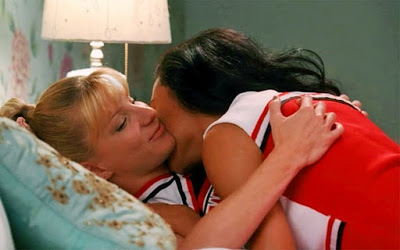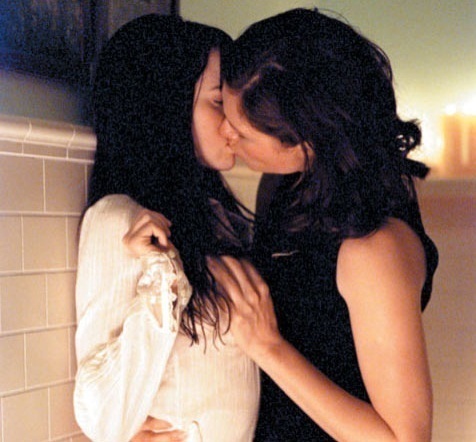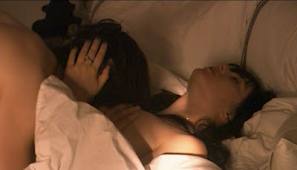
Written by Elizabeth Kiy as part of our theme week on Representations of Female Sexual Desire.
Sadly, it’s still kind of revolutionary to show two women in love having sex or even kissing on TV or in movies that aren’t super niche or ghettoized as pornographic or gay-interest. However, it’s easy enough to see a nominally straight character go gay for sweeps week or two girls making out for male approval in mainstream media. What’s truly scandalous is when the women like it.
Today’s media landscape is fuller than ever with queer characters (though most of them are still white and/or male), yet the stories we see are still most commonly either angst-ridden fumbling toward a coming out or pregnancy and adoption dramas. It’s rare to see a fully realized queer character, too old for coming out and too young for children, actually dating and enjoying sexual encounters. It’s rarer still when it’s a woman.
While gay men are often portrayed as hypersexual partiers, gay women in movies and TV are more likely to worry about their kids, sit on the couch reading together or have rare sex. They’re more like best friends who’ve decided to move in and raise children together than romantic partners (though Modern Family was notably criticized for the lack of passion between its gay male couple, Cam and Mitchell, who didn’t kiss onscreen until the second season of the series). It’s a distinction most notable in the common description of The Kids are Alright, a movie where a lesbian couple have only unsatisfying sex and affairs as “The Lesbian Brokeback Mountain,” comparing it to a film where a gay male couple have a passionate and enduring albeit tortured love affair.
Though there have been some notable deviations from this pattern.
Last year, Blue is the Warmest Color exploded into mainstream discussion for its long and graphic sex scenes, but many viewers felt the scenes were steeped in the male gaze (descriptions of the director Abdellatif Kechiche’s behavior didn’t help matters). Some felt the sex scenes seemed like more of a break from the narrative than genuine portrayal of the character’s passion for each other.
On Glee, Brittany (Heather Morris) and Santana’s (Naya Rivera) relationship began with sex, as they described regularly scissoring each other and were shown in bed together before any idea was given of their feelings for each other. All the emotional stuff between them was added in later. However, when they became an official couple, supposedly in love, the characters stopped interacting, and viewers had to fight to get an onscreen kiss.

On Grey’s Anatomy, Erica Hahn (Brooke Smith) was moved to tears after her first sexual experience with a woman, which caused her to reassess the way she had been living her life. She compared it to getting glasses as a child and finally seeing the world clearly, after years of unknowingly looking at blurs and not knowing they were supposed to be leaves.
It also stood out when Emily Fitch (Kathryn Prescott) officially came out in the second generation of British drama, Skins, expressing her sexual interest in women. She didn’t just vaguely “like” girls or want to date them, she wanted to have sex with them and explained, “I like their rosey lips, their hard nipples, bums, soft thighs. I like tits and fanny, you know?”
The L Word, the lesbian drama which ran from 2004-2009 on Showtime, is remembered by queer women for problems like its hackneyed writing, transphobia, and bierasure, or its place in their realization of their sexuality, but it has an important role as perhaps the only mainstream TV series where all the major characters were queer women. It’s also the only program where you can list out its top ten lesbian sex scenes.

The series was promoted as the queer version of Sex and the City (ads proclaimed “Same Sex, Different City”), and it’s a fairly apt comparison. It focuses on the professional and romantic lives of a group of affluent and fairly feminine queer women in their 20s and 30s living in LA’s gay mecca, West Hollywood, where their lives often intersect with celebrities.
Part of Sex and the City’s enduring position in popular culture is the ease by which the characters, even if you loved them and knew all the particulars of their lives, can be explained by types. We’ve all been asked: are you glamor-loving Carrie, traditional Charlotte, cynical Miranda or sexually liberated Samantha? Likewise, The L Word characters, like uptight power lesbian Bette (Jennifer Beals), earthy valley girl Tina (Laurel Holloman), awkward, closeted athlete Dana (Erin Daniels), social butterfly Alice (Leisha Hailey): the main cast’s only bisexual, and Jenny (Mia Kirshner), a confused midwestern transplant turned sociopath, are such clear types, it’s hard to imagine they’re friends. As THE lesbian show, the series is often posed as representative of lesbian life and love, the awful theme song even proclaims, “This is the way that we live!” Therefore the situations and other characters the protagonists run into are also played as typical.

With a cast (excluding male guest stars and short lived series regulars) of women, the show is ruled by female sexual desire and characters’ libidos and sexual pleasure are integral parts of the plot and of the sex scenes. Characters talk sex over coffee, give each other tips, worry about whether their partner orgasmed, fight attraction so strong it’s all-consuming and, in one episode, debate the meaning of female ejaculation. Most are young and single and spend their nights at parties and clubs, a far cry from the stereotype of lesbians staying home with their cats.
It also worked to debunk commonly held patriarchal ideas that sexual intercourse means penetration or requires a penis as women are shown receiving pleasure from different kinds of sex, involving dirty talk, roleplay, toys, hands and mouths.

In fact, the series is often viewed as a sexual primer, answering the curiosities of straight viewers and teaching basic techniques to baby queers. While women are often portrayed in the media as having sex only because the men in their lives desire it, The L Word characters enjoy sex and participate in it for their own sakes, without men to pressure them. In fact, sex between women in the show is often portrayed as more satisfying because sex scenes between women are longer, more explicit and more intense than scenes with men. A lot of attention is also given to the idea that a woman has superior knowledge of the female body because she has one herself. Likewise, Shane, the lesbian Casanova, is desired by every queer woman and most straight women she meets.

Right off the bat, lesbian sexuality is taken seriously as the first major plot line follows Jenny, consumed by her sexual desire for a woman named Marina despite all logic. By end of pilot, we see them have sex and see it as an amazing eye-opening and life-changing experience for her.
Still, the series can be accused of titillation, and as a mainstream production, it required the interest of straight male viewers to stay on the air. In a season two plot line, the series attempted to address the idea of the male gaze and rape culture with the inclusion of a straight male character who moved in with Jenny and Shane and filmed them without their permission. All the women are gorgeous and feminine (Shane, the most masculine is still thin and stylish), which led to criticism from queer viewers that the show was making the characters more familiar and digestible for straight audiences. On the other hand, The L Word has also been praised for breaking down stereotypes and teaching audiences that not all lesbians are butch.
Still, knowledge that the series came from lesbian creator Ilene Chaiken and involved several queer actresses, guest stars and episode directors allowed queer women to feel a degree of ownership and (often begrudging) affection toward the program. The community complained about it, but still held viewing parties, all hated Jenny together, and voted the stars on hot lists throughout its run.
In season five, the show even pokes fun at the portrayal of lesbian sex in the mainstream when characters get involved in the production of a movie based on their lives. Jenny has to give the cast, who are mostly straight, lessons on how queer women have sex as they have no idea how to portray it accurately. In another episode, a producer gives the ridiculous suggestion that the actresses could have unsimulated sex in the film as the MPAA wouldn’t consider it “real sex.” His suggestion is made more ridiculous by the fact that MPAA guidelines are actually tougher towards portrayals of queer sex than straight sex, and there are numerous examples of scenes of female pleasure garnering NC-17 ratings (as in seen in the documentary This Film is Not Yet Rated).
Though there are examples of movies and TV where lesbian sexual desire and romance are portrayed along with lesbian sex (and I’m sure I’ve missed some), unfortunately, there isn’t another show with an ensemble full of queer women where their sexual desires and sex lives are taken seriously and given consistent airtime. Love or hate The L Word, its portrayal of queer women as sexual beings was, and still is, important.
____________________________________________________________
Elizabeth Kiy is a Canadian writer and freelance journalist living in Toronto, Ontario.